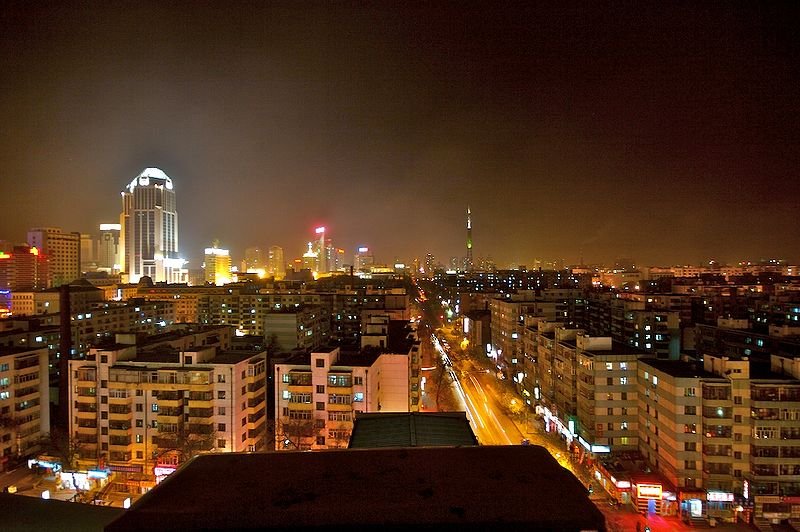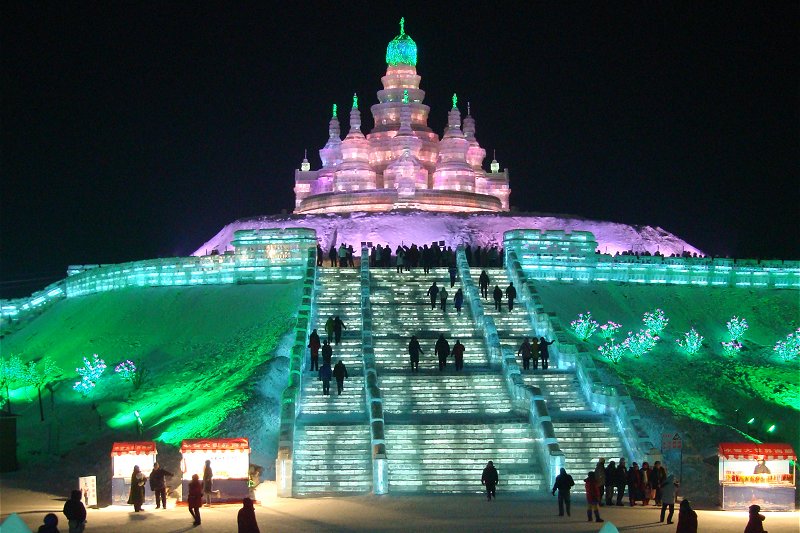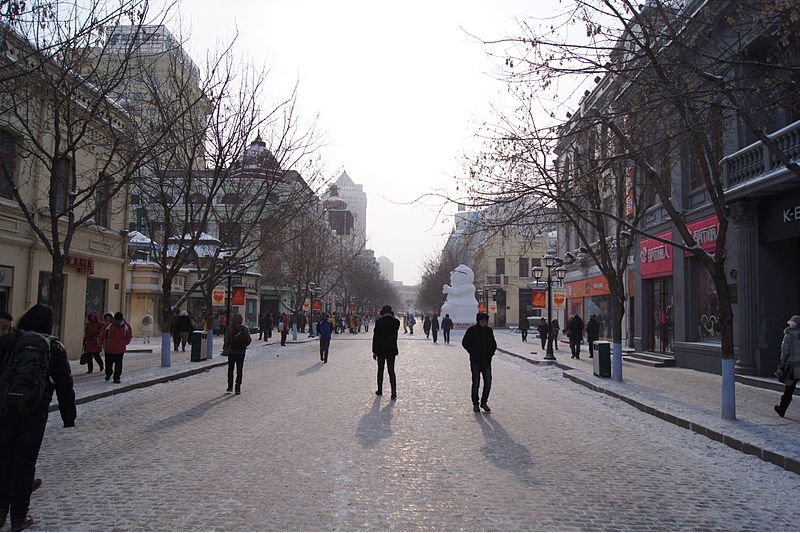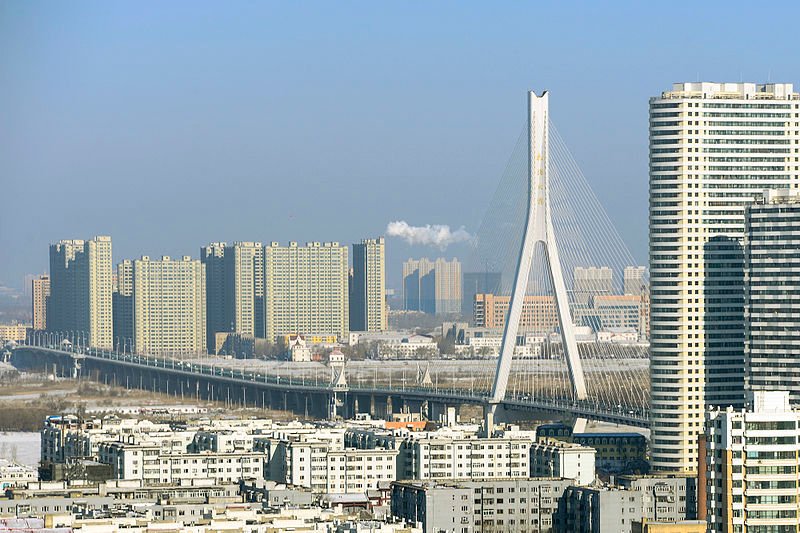

Harbin 哈尔滨
 Go Back - Latest PENANG Sights/Streets/New Properties > Malaysia > World | Hokkien : Lessons : Dictionary | YouTube | Facebook | About Me : Contact Me
Go Back - Latest PENANG Sights/Streets/New Properties > Malaysia > World | Hokkien : Lessons : Dictionary | YouTube | Facebook | About Me : Contact Me Harbin, Heilongjiang Province, China
Harbin, Heilongjiang Province, ChinaSource: https://commons.wikimedia.org/wiki/File:Harbin_at_Night.jpg
Author: julharton

Harbin (哈尔滨) is the capital and largest city in Heilongjiang Province, in northeastern China. It is a sub-provincial city. Its urban area covers 2,089 sq km (806 sq mi) while the sub-provincial city limits cover 53,068 sq km (20,489 sq mi). Harbin has an urban population of 4.5 million people and a sub-provincial city population of 10.6 million. It is the 10th biggest city in China. It is itself subdivided into eight district, three county-level cities and seven counties.
Harbin is located on the southeastern edge of the Songnen Plain. The city is on the southern bank of the Songhua River. The city experiences a monsoon-influenced humid continental climate. The city is famous for its bitterly cold winters. January is the coldest month, when average low temperature may drop to -24°C. Warmest month is July, when temperatures reach 28°C. July is also the wettest month, with 143 mm of precipitation.
The Harbin area has seen human habitation going back to at least 2,200 BC. The modern city was established in 1898, on the site of a small village, by Polish engineer Adam Szydłowski, when the Chinese Eastern Railway line was being constructed. The railway line was financed by Russia, and the city bear evidence of Russian architecture from those early days.
Russian influence in Harbin waned following the Russian defeat in the Russo-Japanese War of 1904-05. Harbin had a head start in industry, commerce and banking for northeastern China. It is a cosmopolitan city with communities of Jews, Poles, Germans, Tatars, Latvians, Georgians and other East Europeans.
Until the late 1940's, the Russian population in Harbin outnumbered ethnic Chinese and Manchus. The majority were refugees who fled Russia after the communist take over. In the mid 1950's, as China also fell to Communist rule, they emigrated in large numbers to Australia, Brazil and the United States. By the late 1980's, the Russian population of Harbin numbered just 30 elderly persons.
 Harbin Ice and Snow World
Harbin Ice and Snow WorldSource: https://commons.wikimedia.org/wiki/File:Harbin_Ice_and_Snow_World_2010.jpg
Author: Dayou_X

Harbin has grown rapidly in recent years, its economy propelled by the availability of natural resources, good transport infrastructure and abundant human resources. It is gearing itself to be a regional trading and retail hub. The city also has a diversified manufacturing base that includes light industries, textile, medicine, foodstuff, automobile, and metallurgy, among others.
Harbin has built a worldwide reputation for its winter culture. The annual Harbin International Ice and Snow Sculpture Festival is one of the four major ice and snow festivals, ranking alongside the Sapporo Snow Festival of Japan, Quebec City Winter Carnival of Canada and Ski Festival of Norway.
 Street in Harbin
Street in HarbinSource: https://commons.wikimedia.org/wiki/File:Harbin_Street.jpg
Author: Fredrik Rubensson

Planning your trip to Harbin
The Harbin Taiping International Airport (HRB) is the largest airport in northeastern China. In addition to flights from major cities in China, it also receives flights from Hong Kong, Krasnoyarsk, Seoul, Vladivostok and Yakutsk. The airport is 33 km (21 mi) to the southwest of downtown Harbin. There is a bus service connecting the airport to the city. The fare is ¥20. Taxis are also available for between ¥100 to ¥120 depending on destination.You can also reach Harbin by train. The journey from Beijing takes up to 18 hours.
 Songpu River Bridge in Harbin, Heilongjiang Province
Songpu River Bridge in Harbin, Heilongjiang ProvinceSource: https://commons.wikimedia.org/wiki/File:Songpu_Bridge,_Harbin_city.jpg
Author: siyang xue

Exploring Harbin
Taxis are relatively inexpensive in Harbin, and is the usual mode of transport for foreign visitors to the city.Places of Interest in Harbin
- Church of St Sofia
- Flood Control Monument
- Harbin Northern Forest Zoo
- Japanese Germ Warfare Experimental Base
- Jile Si
- Provincial Museum
- Qiji Futu Pagoda
- Stalin Park
- Sun Island Park
- Zhaolin Park
- Zhongyang Dajie
 Latest updates on Penang Travel Tips
Latest updates on Penang Travel Tips
 Discover with Timothy YouTube Channel
Discover with Timothy YouTube Channel
 PG Food Channel
PG Food Channel
 Learn Penang Hokkien YouTube Channel
Learn Penang Hokkien YouTube Channel
 SojiMart Videos
SojiMart Videos
 Share your travels and/or ask a travel-related question
Share your travels and/or ask a travel-related question
Join the Penang Travel Tips Facebook Group to share photos, tips and anything related to your travels, or ask travel-related questions.
 Map of Roads in Penang
Map of Roads in Penang
Looking for information on Penang? Use this Map of Roads in Penang to zoom in on information about Penang, brought to you road by road. Discover with Timothy
Discover with Timothy
Let me take you to explore and discover Penang through my series of walking tours on YouTube. You may use these videos as your virtual tour guide. At the beginning of each video, I provide the starting point coordinates which you may key into your GPS, Google Maps or Waze, to be navigated to where I start the walk, and use the video as your virtual tour guide.Disclaimer
Please use the information on this page as guidance only. The author endeavours to update the information on this page from time to time, but regrets any inaccuracies if there be any.Latest from Discover with Timothy: Gurney Bay - what to see and do there
About this website

Hello and thanks for reading this page. My name is Timothy and my hobby is in describing places so that I can share the information with the general public. My website has become the go to site for a lot of people including students, teachers, journalists, etc. whenever they seek information on places, particularly those in Malaysia and Singapore. I have been doing this since 5 January 2003, for over twenty years already. You can read about me at Discover Timothy. By now I have compiled information on thousands of places, mostly in Peninsular Malaysia and Singapore, and I continue to add more almost every day. My goal is to describe every street in every town in Malaysia and Singapore.
Robbie's Roadmap
- Episode 1: Robbie's Journey to Financial Freedom
- Episode 2: Lost in America
- Episode 3: The Value of Money
- Episode 4: The Mentor
- Episode 5: The Thing that Makes Money
- Episode 6: The walk with a Billionaire
- Episode 7: The Financial Freedom Awakening
- Episode 8: Meet Mr Washington
- Episode 9: The Pizzeria Incident
Copyright © 2003-2024 Timothy Tye. All Rights Reserved.